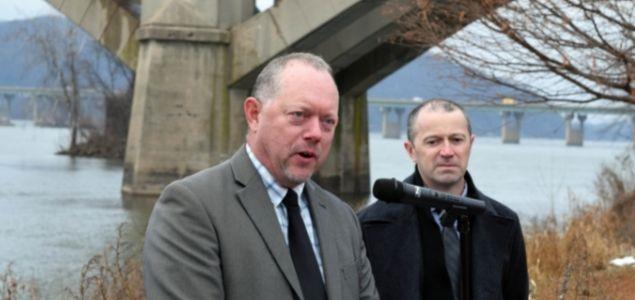
When Wolf administration officials wanted to highlight benefits from the passage of the federal Bipartisan Infrastructure Law (BIL), they had to look no farther than PennDOT District 8's Route 462 Veterans Memorial Bridge.
Known locally as the Columbia-Wrightsville Bridge, the bridge spans the Susquehanna River, connecting the historic communities of Columbia in Lancaster County, and Wrightsville in York County. The 1.26-mile-long bridge, itself a historic structure, was built in 1930 and is listed on the National Register of Historic Places. The bridge is slated to undergo a major rehabilitation project beginning in 2023.
During a media event held at Columbia River Park with the bridge as a backdrop, PennDOT Acting Deputy Secretary for Highway Administration Mike Keiser, Acting District 8 Executive Chris Kufro, and DCNR Recreation and Conservation Manager Lori Yeich highlighted benefits of the law, including its impact on the state's bridges.
"The passage of the Bipartisan Infrastructure Law is the largest federal infrastructure investment in decades, and the largest ever investment for bridges specifically," said Acting Deputy Secretary Keiser.
In addition to the Columbia-Wrightsville Bridge being "one of Pennsylvania's most picturesque," it also includes an important bike route and connects parks and other recreational amenities on either side of the river, he said.
He noted that investing in infrastructure – whether highways and bridges, bike and pedestrian facilities, or trails and parks – has historically paid dividends for the communities in which they are located. This type of infrastructure has been "chronically underfunded for many years, which makes these investments even more challenging," he added.
The new law is largest infrastructure investment since 1993. "We really hadn't had any adjustment at the federal level since that time," he said.
Pennsylvania is expected to receive an estimated $4 billion in new federal highway and bridge funding over five years, including an estimated $1.6 billion for bridges.
The bridge funding is welcomed, as the state is home to a large number of state and local bridges, many of them aging, Keiser said. Each year, about 250 bridges are added to the state's list of bridges in poor condition, he noted.
"Pennsylvania is ready to put these funds to good use on meaningful projects that will modernize our infrastructure and create sustainable, good-paying jobs that will be transformative of our transportation system and local economies," he added.
Acting District 8 Executive Chris Kufro noted the river park was an excellent location to discuss infrastructure funding. The Columbia-Wrightsville Bridge is iconic, he said, and plays a major role in the economies and quality of life of the communities on either side of the river.
"It is long overdue for another major rehab so it can be enjoyed for future generations," he said.
He lauded the excellent project collaboration PennDOT has had with local communities as the bridge project has been developed. "They provided valuable input, not only toward the bridge, but also toward key enhancements that will be part of the project corridor," he said.
This includes bicycle and pedestrian enhancements that will "regionally connect a wealth of local recreational parks and trails immediately on each side of the bridge."
The communities also provided valuable input into the bridge's adjacent intersections, which are being designed as gateways to both historic communities, he added.
"And finally, stakeholders are also providing feedback into the proposed lighting enhancements on the bridge, that will not only help all three modes of transportation on the bridge but will be readily viewed from residence and businesses that line the riverfronts," he said.
"We appreciate the spirit of cooperation and look forward to advancing this project, which is vital to the communities and the region," he said.
DCNR's Lori Yeich said the bridge project is an excellent opportunity to increase connections between communities on either side of the river, as well as regional trail systems.
She said most people think of traditional infrastructure as that which accommodates motor vehicle – cars, truck and motorcycles.
"We have all joined together in a partnership to connect other modes of transportation just as important, and that is to connect people through bicycles and pedestrian accommodations."
Creating infrastructure that connects people to places they care about also creates infrastructure for sustainable economic development, she said.
ABOUT THIS BLOG
Did you know PennDOT is directly responsible for nearly 40,000 miles of highway and roughly 25,000 bridges? We oversee programs and policies affecting highways, urban and rural public transportation, airports, railroads, ports and waterways, in addition to administering the state's more than 11 million vehicle registrations and 8.8 million driver's licenses.
So, how do we do what we do? And how can we help you travel in Pennsylvania — whether it be for business or leisure — in safe and enjoyable manner? Read PennDOT Way to learn more about the department, what we do, and how and why we do it.
TAGS
50-Year Anniversary, 511PA, Aggressive Driving, Airports, Autonomous Vehicles, Bicycles, Bridges, Child Safety, Community Relations, Construction, COVID-19, Distracted Driving, District 1, District 10, District 11, District 12, District 2, District 3, District 4, District 5, District 6, District 8, District 9, DOTcom, Driver and Vehicle Services, Emergency Responders, Employment, Equity, FAQ Friday, Human Trafficking, Impaired Driving, Innovations, Live Free Ride Alive, Maintenance Monday, Motorcycles, Older Drivers, PA Motorcycle Safety Program, Pedestrians, PennDOT Connects, Ports, Public Transit, Railroads, REAL ID, Road MaP, Roadside Beautification, Rural Roads, Safety, School Buses, Seat Belts, State Transportation Innovation Council (STIC), Sustainability, Teen Drivers, Throwback Thursday, Transportation Funding, Travel in PA, Welcome Centers, Winter, Work Smart, Work Zone, Yellow Dot
LATEST POSTS
PennDOT Continues Sharing, Updating Resources for Local Governments to Pursue Bipartisan Infrastructure Law Funding Opportunities
Norwin High School Wins 2024 ‘Innovations Challenge’
Demo Complete: I-95 CAP Project in Center City Philadelphia
PennDOT Archeologist Connects Past, Present, and Future
Lehigh Valley DUI, Highway Safety Task Force Hosts Law Enforcement Seminar
ARCHIVES
2024
2023
2022
2021
2020
2019
2018
2017

